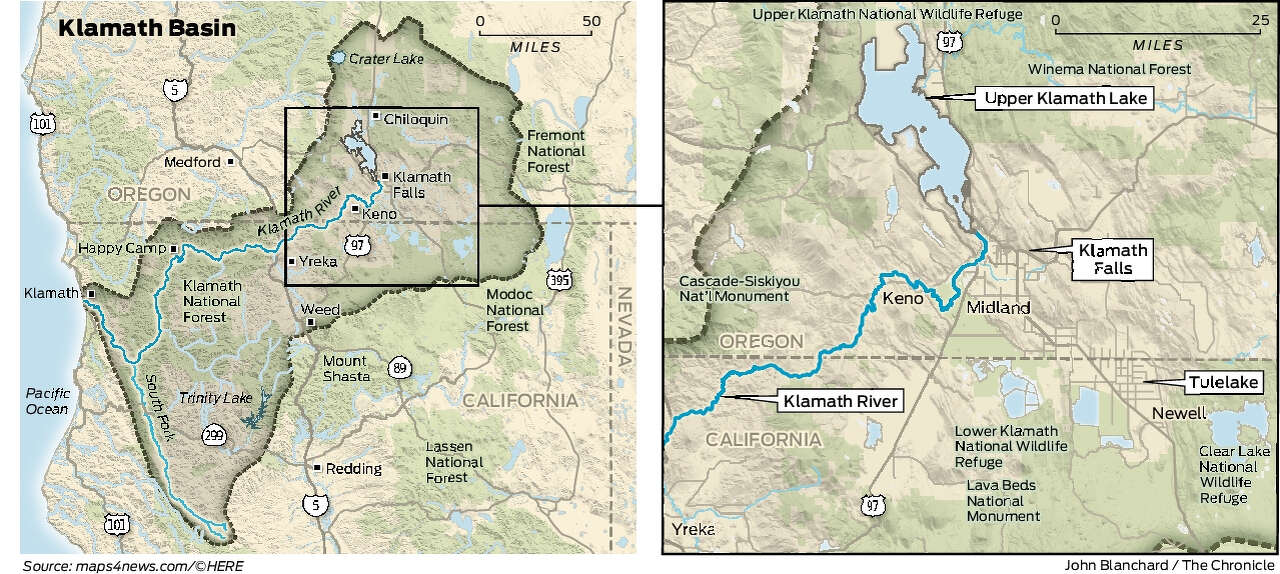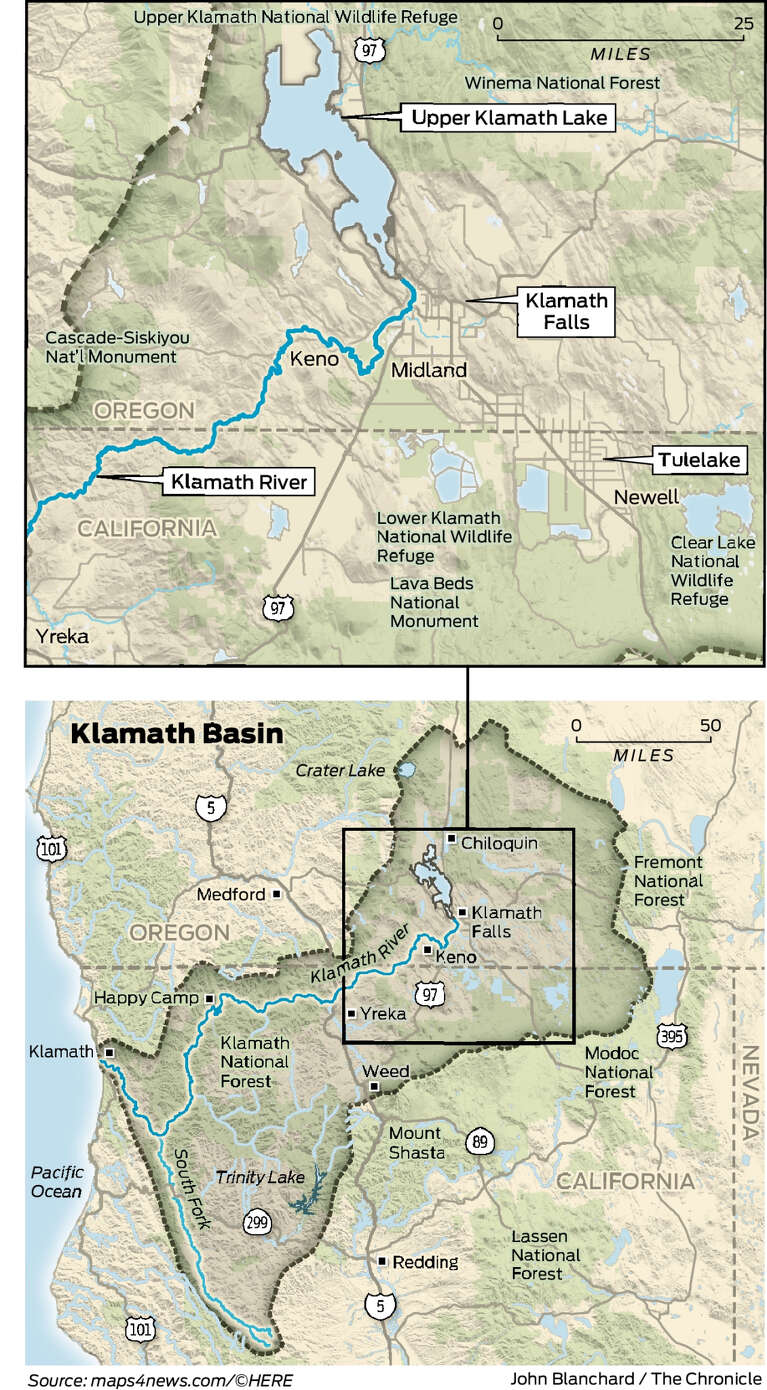In the Klamath Basin, farmers, fish, water managers all feel the pain from drought
Nowhere has California’s dry winter hit harder than the state’s far north.
In a handful of counties along the rural Oregon border, where late-season rains have done little to sate the parched forests and dusty plains, hundreds of farmers are at risk of having their irrigation water shut off — and watching their crops wither in the field.
The Klamath Project, a U.S. government-operated waterworks that steers runoff from the towering Cascades to more than 200,000 acres of potatoes, alfalfa, wheat, onions and other produce on both sides of the state line, is running low on supplies. The local water agencies served by the project say they may not have water to send to farms beyond next month.
The last time irrigation supplies were this scarce in the upper Klamath Basin, 350 miles north of San Francisco, federal marshals were called in to maintain order after angry residents broke through a project head gate in protest. Nineteen years later, the prospect of running out of water arrives as the farm-dependent region faces the additional hardship of the coronavirus outbreak. Many businesses here have had to close or cut hours during the pandemic, leaving little cushion for the imminent fallout of drought.


“I’m very concerned,” said Leah Ross, 62, owner of a small convenience store, Ross Market, in Tulelake (Siskiyou County). “I love this place. But without water and because of the coronavirus, the income into town is less. Families move away. It’s tough to make ends meet.”
Even before the recent trials, the town of Tulelake, like many of the neighboring communities in this remote, high-elevation basin, showed the economic scars of empty storefronts, rundown barns and abandoned produce warehouses. The population has slipped over the past two decades, with the loss of farm jobs, and fewer than 1,000 people live here today.
Already this year, little water is flowing to the fields that sprawl in every direction from town to the browning foothills that flank the region. The local irrigation district is trying to conserve supplies to prepare for the anticipated shutoff.

Still, growers like Ben DuVal, 39, say there’s no way their crops will make it through the growing season, which sometimes runs to late fall, if project supplies dry up. DuVal, who farms alfalfa on a couple of hundred acres south of town, says he’s watered his land enough to ensure one alfalfa cutting this year but he can’t count on his usual three or four.
“The first cutting goes to the bills,” he said. “I need the other cuttings to support the family.”
Additionally, if DuVal doesn’t provide hay to his buyers, some of whom are halfway around the world — including Saudi Arabia and South Korea — they will turn elsewhere and may never come back.
“This water thing scares me to death,” he said.
The 1,200 farms in California and Oregon that rely on the project’s water knew it was going to be a difficult season.

As of last week, the region had received barely half the precipitation it typically gets at this point in the water year, which begins Oct. 1. Oregon Gov. Kate Brown has declared a drought emergency north of the state line while the situation on the California side is categorized as “severe” by the U.S. Drought Monitor.
Little runoff has come from the mountains that feed the project’s primary water source, the Upper Klamath Lake near Klamath Falls, Ore., and the 250-mile-long Klamath River, which flows from the lake to the California coast.
“I grew up here and I’ve never seen it this dry,” said Tricia Hill, 43, who farms potatoes, grains and alfalfa in California and Oregon. “You could watch the cows walk in April and see dust come out of the grass.”
Making matters worse for the growers, the Bureau of Reclamation, which runs the water project, recently had to adjust the amount it expects to provide for agriculture this year in light of the weather. The April 1 estimate of 140,000 acre-feet of water, already far less than the full annual allocation of 350,000 acre-feet, dropped to 80,000 acre-feet.

An acre-foot is 326,000 gallons, about enough water to cover a football field at a depth of 1 foot.
Most farmers in the basin made their planting decisions based on the April 1 water estimate, and even as that required them to scale back, learning this month that they’re still overextended hurt more.
“What’s going to happen when there’s no water in the ditch?” Hill wondered. “What’s going to happen to our small communities? My husband and I have had conversations and, frankly, I’ve cried a lot. I’ve had to have my children watch me cry, which is tough.”
A third of the project’s revised allocation has already been shipped out, which leaves about 55,000 acre-feet of irrigation water for the rest of the season. It’s an amount that everyone agrees is too little for the more than $300 million worth of crops annually harvested in the basin.
“There’s just simply not enough water this year,” said Jeff Nettleton, the Bureau of Reclamation’s area manager. “Everyone is disappointed and frustrated.”

On top of drought conditions, project deliveries are constrained by regulations that protect native fish. The Bureau of Reclamation is obligated to keep a minimum amount of water in Upper Klamath Lake for endangered suckerfish while sending a minimum amount of water down the Klamath River for threatened salmon.
With so little water available recently, the Bureau of Reclamation diverged from the project’s agreed-upon deliveries two weeks ago and began limiting downstream flows that the salmon count on. Nettleton said “the drastic change in hydrology” left no choice but to exercise a stipulation in a region-wide agreement on allocations that calls for working with farmers, fish advocates and others to renegotiate how project water is divvied up.
The parties have been meeting but to no avail, and the lack of consensus has only opened a new front in the basin’s long-running water war.
On May 13, groups concerned about the salmon, including fishermen and members of the Yurok Tribe, revived an ongoing legal fight against the Bureau of Reclamation, claiming in the U.S. District Court in San Francisco that the agency had abandoned its water commitments and put the needs of farmers ahead of fish.
The motion they filed demands that the agency release 23,000 acre-feet of water down the Klamath River for salmon. The higher flows, the filing says, are particularly important in spring. They help juvenile coho swim to sea and flush out a parasite known to kill both coho and chinook.
“We have to fight for the fish as if our lives depend on it,” said Yurok Vice Chair Frankie Myers, whose tribe lives in Humboldt and Del Norte counties, several hours southwest of the basin’s farms, but similarly relies on the Klamath’s water — for food and ritual.
Myers said he knows the farmers are struggling, though he thinks the agricultural community has come to expect too much and that a reckoning is inevitable.
“We really are trying to find a balance,” he said. “But if we live outside of our means we are heading down a path that will lead to the destruction of all our communities.”

On Friday, a federal judge said he was not likely to grant the request by the Yurok and others for more water for salmon. He said he wants the parties to continue to work among themselves to figure out how this year’s scant water supply is distributed.
Farmers say they’ve been making sacrifices for years. Many point to 2001, when almost no project water was provided to irrigate the fields in order to help the fish. That year, protests erupted among growers, hastening the push for a grand compromise on water supplies that, to this day, remains elusive.
The tussle over water allocations has since been an annual exercise in the basin, hitting another peak in 2018 just after California’s five-year drought. Most say this year’s fight, with so many crops in the ground at risk of perishing, has much greater stakes.
“At some point this has to stop,” said Scott Seus, 46, a farmer outside of Tulelake who grows horseradish and mint, among other regional staples. “I don’t think any of us are opposed to fish. At the same time, we have to have something here that keeps us going.”
With little hope of sufficient water, the Bureau of Reclamation is working with the U.S. Department of Agriculture to secure financial aide for farmers in the basin. The Klamath Project Drought Response Agency, a consortium of local government groups, is also tapping federal funds for those who lose their water.
Meanwhile, managers of the Klamath Project are trying to augment supplies, even if only a bit, possibly transferring water from other federal reservoirs or buying it from nearby hydroelectric facilities, to salvage as many of the crops as possible.
“We’re looking at all the types of options,” said Dave Felstul, area water operations chief for the Bureau of Reclamation. “But we just haven’t seen much runoff from the snowpack we had this year. And the snowpack was already on the low side.”
“It’s definitely going to be challenging,” he said.
Kurtis Alexander is a San Francisco Chronicle staff writer. Email: kalexander@sfchronicle.com Twitter: @kurtisalexander